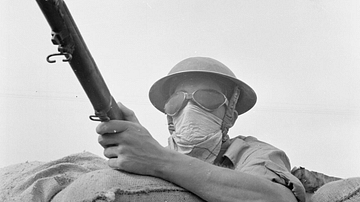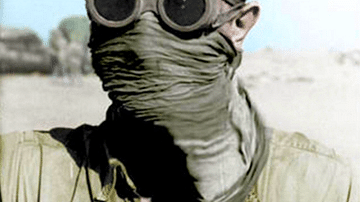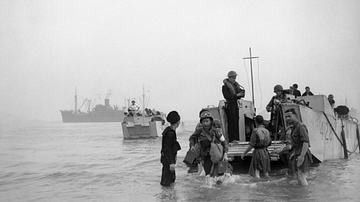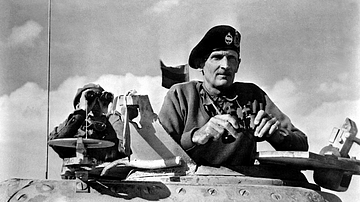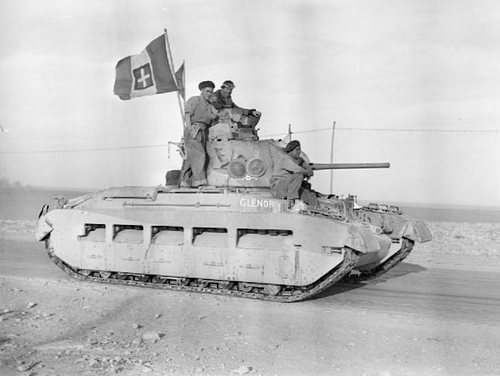
Operation Compass (9 Dec 1940 to 7 Feb 1941) was an Allied offensive in North Africa, which pushed Italian forces out of Egypt and then Cyrenaica (Eastern Libya). The Allied Western Desert Force, led by Lieutenant-General Richard O'Connor (1889-1981), inflicted numerous heavy defeats on the Italian army commanded by Marshal Rodolfo Graziani (1882-1955).
The Italian army was poorly trained and equipped with their troops often so eager to surrender that the Allies captured an incredible 138,000 prisoners. Operation Compass thus gained the Allies control of the Western Desert. The Axis powers would fight back, but Compass was a much-needed victory for the Allies after enduring nothing but defeats so far in the war.
The Importance of North Africa
After WWII broke out in Europe in September 1939, the Allies, then principally British and Commonwealth forces, were particularly keen to protect the Suez Canal from falling into the control of the Axis powers of Germany and Italy. The loss of the canal would have effectively cut the British Empire in half. North Africa was also strategically important to both sides' wish to control and protect vital Mediterranean shipping routes. The island of Malta was also crucial in this role and holding the island fortress (then in British hands) was another reason to control potential airfields in the North African desert. Finally, North Africa was the only place where Britain could fight a land war against Germany and Italy and so hopefully gain much-needed victories that would encourage the British people after the debacle of the Dunkirk Evacuation and the horrors of the London Blitz. For all of the above reasons, a series of desert battles ensued, which are collectively known as the Western Desert Campaigns (June 1940 to January 1943).
The desert war involved battles that could range over many miles as, relative to other theatres of the war, territorial gains became much less important than inflicting material damage on the enemy. Other peculiarities of desert warfare included the general absence of any civilian involvement and the fact that both sides frequently used captured equipment, a phenomenon that often made positive identification of exactly who was who difficult. Allied and Axis air forces could only play a limited role in mobile tank battles and so were largely reduced to targeting supply lines or fixed defensive positions.
The Italian Advance
Italy, unsurprisingly, given its established colonial presence in North Africa, was the first Axis power to move against Egypt in September 1940. A force led by Marshal Rodolfo Graziani marched from the Italian colony of Libya – specifically, the eastern province of Cyrenaica – into British-held Egypt. Graziani was an experienced campaigner, leading the Italian forces in Libya's western province of Tripolitania in 1928, acting as vice-governor of Cyrenaica in 1930, and operating as the military governor of Italian Somaliland in 1935. Graziani had led campaigns against the Senussi in 1930 and the Italian invasion of Abyssinia in 1935. Graziani then served as the governor-general of Abyssinia where, just as he had in Cyrenaica, he conducted a campaign of repression so brutal that it sparked a local rebellion. Graziani was made the commander of Italian forces in Libya in June 1940, and so he had at his disposal some 250,000 men. Unfortunately for the fascist Italian leader Benito Mussolini (1883-1945), Graziani and those commanders below him proved to be inept when it came to modern warfare against a modern army. Further, the Italian army was poorly trained and poorly equipped, especially their two Libyan divisions. Following a directive from Mussolini, the 10th Italian Army marched into Egypt on 13 September 1940. The commander on the ground was General Mario Berti. Having covered only a few miles because of their poor transport capabilities, the Italian army dug in at Sidi Barani on 16 September. The Italians built their defences and awaited further supplies at this desert outpost that consisted of little more than a few mud huts and an airstrip.
The Battle of Sidi Barani
The Allied Western Defence Force (WDF) in Egypt was led by Lieutenant-General Richard O'Connor who had experience in several major battles in the First World War (1914-18), had commanded troops on India's hostile North West Frontier, and had acted as military governor of Jerusalem. O'Connor had received three medals of distinction in WWI: the Military Cross, the Distinguished Service Order, and, fighting for the Italians, the Italian Silver Medal for Valour. The commander of the Allied Middle East Forces and so O'Connor's superior, was General Archibald Wavell (1883-1950). Wavell was determined to exploit what he considered the superiority of his men and equipment to deal a serious blow against the enemy, not only in North Africa but also in Eritrea and Abyssinia. O'Connor was similarly confident, noting of his troops that their "morale was extremely high and they were very well trained. The enemy, on the other hand, had a vast numerical superiority, something in the nature of eight to one, but their morale was low and they had no interest or enthusiasm for the war at all" (Holmes, 152-3).
British Prime Minister Winston Churchill (1874-1965) wholeheartedly approved of Wavell's plan to go on the attack. The WDF, with around 31,000 troops, which included British, Indian, and New Zealand soldiers, was greatly inferior to the Italian force led by Graziani in terms of numbers. The WDF was boosted by around 150 additional tanks, which had arrived from Britain in September. These new tanks included the superior Matilda tanks whose armour proved impenetrable to the antiquated Italian tanks. Wavell's secret plan was to attack Sidi Barani and, if things worked out well there, to push on into Libya.

The WDF armour, infantry, and artillery units, with air support from the Royal Air Force, attacked the various Italian fortified camps around Sidi Barani on 9 December. Significantly, the camps had been set too far apart to assist each other during the attack. O'Connor achieved surprise by attacking the camps from the rear, picking them off one by one. At the same time as the infantry and tanks went in, Royal Navy vessels in the Mediterranean bombarded the enemy. Caught by surprise, the Italian forces immediately lost 25 tanks, and General Maletti, a divisional commander, was killed. The British 4th Armoured Brigade took control of the only coast road, and already after day one of the five-day operation, the British were taking thousands of prisoners and capturing huge quantities of valuable equipment and stores. As Lieutenant Paolo Colacicchi of the Italian 10th Army noted, the British force was "certainly better trained, better equipped especially in transport and tanks and armoured cars, and also at the top had generals who were certainly more aggressively minded than ours" (Holmes, 154).
Day two at Sidi Barani saw the Italian forces rally somewhat, particularly the Blackshirt divisions, and everyone was impeded by a sandstorm and then bouts of torrential rain. Victory for the Allies was at hand, though. With things going well, Wavell diverted the 4th Indian Division to the Sudan as the operation moved into its wider phase. O'Connor had to bear the loss, but he was given the 6th Australian Division (all volunteers) as a replacement, even if this would take some time to become operational. On 11 December, Sidi Barani was taken and more prisoners of war were rounded up. Two Italian divisions slipped away in the night and retreated eastwards. In just three days, the Allies had taken 38,000 prisoners (which included four generals) and suffered just 624 casualties (killed, wounded, or missing). O'Connor had also captured 237 guns and 73 enemy tanks. With most of the Italian force retreating deep into Cyrenaica and only a few isolated pockets still resisting (Capuzzo, Sidi Omar, and Sollum), Wavell ordered O'Connor to push on and see how much Libyan territory he could grab.

The Capture of Bardia
Graziani's Italian force, still around four divisions in strength (40,000 men), regrouped around the fortified town of Bardia. Equipped with around 400 heavy guns, the Italians awaited the WDF's arrival. Meanwhile, the Allies were beginning to feel the problem felt by any army on the move in the desert: how to ensure front-line troops were provided with the transport, fuel, ammunition, and supplies they needed. The inevitable delays caused by logistical necessities meant that the Allied force, now jointly led by O'Connor and Australian Major-General I. G. Mackay, was only ready to attack the well-defended Bardia at the end of December. Punching through the trenches and series of concrete bunkers, the Allied infantry attacked first, establishing a bridgehead that allowed the tanks to follow. More infantry then flowed into the breach.
The 23rd Italian Corps, commanded by Lieutenant-General Annibale Bergonzoli (1884-1973), was defeated in the Battle of Bardia on 3 January 1941; the fortress itself surrendered on 5 January. Thousands of escaping troops were mopped up by the 7th Armoured Division, positioned to the west for just that purpose. The 13th British Corps (as the WDF was now called), with its two brigades of the 6th Australian Division, had won the day. It was the first battle involving Australian troops in North Africa, and they had performed well. The Allies had captured another 38,000 prisoners of war, but not Bergonzoli, who fled on foot to Tobruk. As the on-the-spot Australian journalist Jan Yindrich recorded:
The Australians probably bayoneted very few Italians, because their zeal in mopping up terrified them into surrender. One private took thirty prisoners with a mere whirl of the bayonet…A single Australian officer, with eight men and a Bren gun, captured 2,000 in one cave, and marched them off without further assistance. The prisoners were then marshalled into batches of 500, usually with a single guard, and none tried to escape.
(Lyman, 60)
The scale of the surrenders throughout Operation Compass created a logistical headache for the Allies, and led Anthony Eden (1897-1977), then Foreign Secretary, to write to Churchill reversing the prime minister's famous quote on the Battle of Britain: "Never before has so much been surrendered by so many to so few" (Lyman, 75).
At Bardia, the Allies also captured nearly 500 guns of various types as well as 700 vehicles and 120 tanks. In an arena where material was as vital as fighting men, these captured supplies were crucial as they allowed the Allied force to fight on further westwards. Fewer than 150 Allied soldiers were killed in the Battle of Bardia. Operation Compass was turning into an astonishing campaign of Allied victories. Ignoring his initial numerical advantage, Graziani complained to Mussolini that his army was "a flea against an elephant" (Liddell Hart, 98). The Italians had already lost an incredible eight divisions, but worse was to come.
The Capture of Tobruk
Tobruk was a vital supply port and naval base for any army wishing to operate in this part of Libya and western Egypt. Graziani had 34,000 men, 220 guns, around 90 tanks, and, albeit limited, air support with which to defend Tobruk. Two more Italian divisions were some way away at Derna and Benghazi. O'Connor had his own problems as his rapid advance continued to stretch his supply lines; the Allied soldiers even had to endure half-rations as priority had to be given to the transportation of fuel and ammunition. Wavell could not send reinforcements to O'Connor as he had to divert troops again, this time to assist the defence of Greece (invaded by Italian forces on 28 October) and to face other threats to British interests in the Middle East. O'Connor had to go with what he had, but at least the Italians were having their problems, too. The Italian Air Force, the Regia Aeronautica, was already hampered by flying rather antiquated planes, but these were dramatically reduced in number after the Allies captured the El Adem airfield and repair depot.

Tobruk was attacked from 21 January. A heavy artillery barrage was followed up by a concentrated tank attack on Tobruk's south-eastern defences. Things went well for the Allies in the morning, but by the afternoon, the Italians were using naval vessels to bombard the attackers. The Allies clawed their way forward, and by the end of the day, they had won almost half of the defender's territory. After a night of bombardments, by the morning, the Tobruk garrison had had enough and surrendered. Once again, the Allies gathered in a huge quantity of arms and supplies including 87 tanks and two months' worth of food. The Allies suffered just 400 casualties in the battle. Tobruk's harbour was made serviceable again within 48 hours.
Victories at Derna, Benghazi, & Beda Fomm
The 13th British Corps now headed for the Italian division sitting at Derna and then the even bigger prize of Benghazi. Benghazi was a major port with a population of 65,000. If the Allies could capture Benghazi, it would be a major blow to the Italians' chances of ever recovering from the defeats of Operation Compass. The Allies won a tank battle on 24 January at Mechili. Derna was taken on 30 January. By 4 February, Benghazi was surrounded. In three days, the port was captured. The Italian 10th Army was then roundly defeated at Beda Fomm on 7 February 1941. General Bergonzoli was this time amongst the 25,000 captives taken.
Operation Compass had been a resounding success and had effectively destroyed the Italian army and air force in western Libya. O'Connor had brilliantly led his relatively small force across more than 500 miles (800 km) of desert, inflicting defeat after defeat on the Italian army. "With fewer than 2,000 casualties he shattered 10 enemy divisions, took about 138,000 POWs including five generals, [and] captured 400 tanks and 850 guns" (Boatner, 399). The Italian army suffered some 12,000 killed or missing in action. This was the first major Axis defeat of the war.

Aftermath
Graziani, suffering a nervous breakdown, retired from active duty in March 1941. O'Connor did not fare much better as he found himself captured later on in the Western Desert Campaigns, although he managed to escape and take part in the D-Day Normandy landings of 1944. There were some downsides for the Allies regarding their relatively easy victories in Operation Compass, and these were that "it taught the Commonwealth armies nothing about tank infantry cooperation or the proper handling of the artillery in support of mechanized formations. Neither did the use of anti-tank guns feature in the lessons of the campaign" (Moreman, 31). These lessons would have to be learnt the hard way in the next phase of the desert war.
The Italian army in Tripolitania was significantly boosted in February 1941 by the arrival of German troops who, at this stage of the desert war, were much better trained, equipped, and led than either the Italians or the Allies. The new German armoured division formed what would become the elite Deutsche Afrika Korps (DAK). Things improved further for the Axis powers when General Erwin Rommel (1891-1944) took over command of Axis forces in North Africa. Rommel's official orders were to contain the Allies and focus primarily on defence; these he blithely ignored, and he immediately went on the offensive, taking advantage of the Allies' overstretched resources. Rommel gained El Agheila on 24 March 1941, then Mersa Brega on 1 April, Benghazi on 4 April, and El Mechili on 7 April. Rommel's progress was halted by his unsuccessful siege of Tobruk (April to December 1941), but he gained a great victory at the Battle of Gazala (May-June 1942) and finally captured Tobruk. Rommel, suffering his own supply problems, then lost the initiative at both the First Battle of El Alamein and the Second Battle of El Alamein (July-November 1942). The massive Allied North Africa landings (Operation Torch) in November 1942 marked the beginning of the end for Axis ambitions in North Africa.


